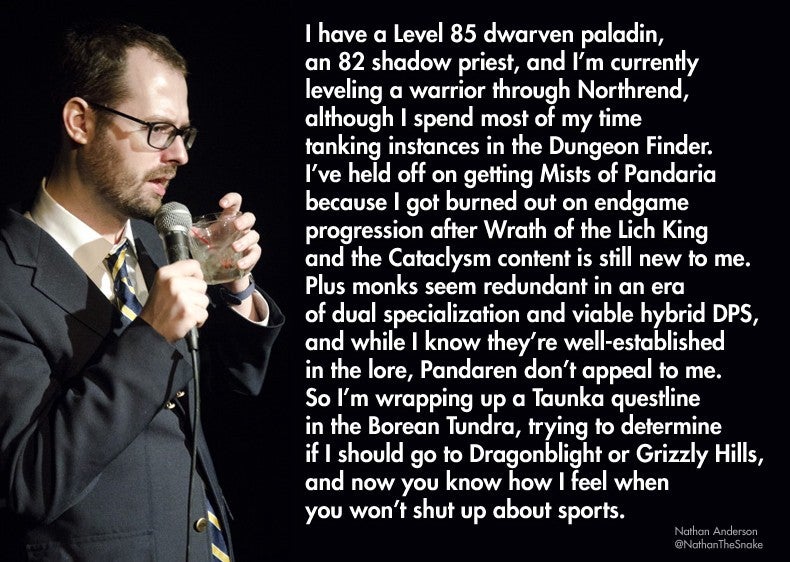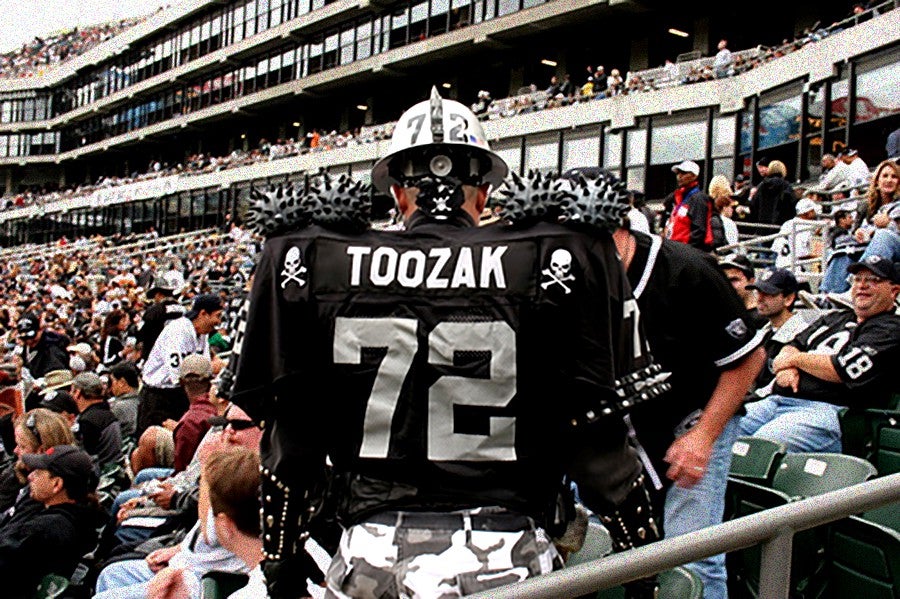Comedian Jake Lambert recently went viral when he tweeted the following:
Two men on my train are laughing at a group of young Star Wars fans because they've dressed up as their favourite characters to go and see the film. The two men are on their way to watch Arsenal, and are both wearing Arsenal shirts.
— Jake Lambert (@LittleLostLad) December 16, 2017
He raises a good point. After all, what would you feel more comfortable doing: Going to a bar wearing an Eagles jersey with Wentz on the back, or going to a bar dressed as Han Solo? Because despite the fact that you aren’t a star quarterback any more than you are a charmingly rogue-ish space smuggler, one of these forms of delusional wish fulfilment is far more socially acceptable than the other.
It’s not just the clothes, either.
Knowing that Willie Mays hit 660 home runs in his career is going to give you social currency in pretty much any scenario where you’re hanging out with guys you’ve never met before. But knowing the name of the episode in which Captain Kirk made out with Uhuru will mostly likely raise some eyebrows, if not outright make you a mark for social exclusion. (It’s “Plato’s Stepchildren,” FYI).
Again, in both cases, all you’re doing is demonstrating a level of expertise, dedication and memory prowess, which should be impressive/tedious (delete as you see fit) regardless of subject matter. Yet one form of nerd-dom — and make no mistake, the hardcore sports fan’s obsession with stats and figures is supremely nerdy — is much more acceptable than the other.

But why?
Or to put it more accurately, why is sports nerd-dom so much more socially acceptable — and so much more forgivable amongst men — than video games, comics or other types of geekiness?
“It could be something to do with class,” says Jack Fawbert, lecturer at Britain’s Anglia Ruskin university, and author of Representations of Change–Class, Community, Culture and Replica Football Shirts. For British sports culture, at least, football (that is, soccer) has always traditionally been a working-class thing, a tough thing, and to support a team is to align yourselves with a gritty history — a real one, not one invented by George “white sneakers and beard” Lucas.
“[Soccer] has certainly been a working-class game for over a century, although it started as a game played by public school [in the U.K., ‘public school’ actually means ‘private school’] ‘gentlemen,’ and was adopted by urban working-class communities after it was used as an instrument of missionary work in those communities,” says Fawbert. “There, they had strong bonds of working-class solidarity, and the game was adopted to the greatest extent as a representative of locality and fierce local pride.”
What’s interesting is that for the working class — both in Britain and the U.S. — it’s not so much about the playing of the sport, as watching it. “The working class have always shown a tendency for spectating, more than the middle and upper classes,” says Fawbert, explaining that this, in turn, led them to adopt their team’s colors.
Still, the full-on cosplay aspect of wearing a player’s jersey is a relatively recent phenomenon. “In the U.K., up to the late 1970s, fans just wore rosettes, or home-knitted scarves and bobble hats [in the team’s colors],” says Fawbert. “Replica shirts became a big thing in the early 1980s, and started with fans actually getting hold of and wearing players’ shirts. Clubs caught on that there was probably a lucrative market there — the mass marketing of West Ham replica shirts started in 1981, for example. In the early days they were just worn for matches, but it became fashionable to wear them as leisure wear. Clubs jumped on the bandwagon and soon started introducing third kits and changing their strips more often in order to increase revenue.”
One aspect worth consideration here is that the wearing of sports jerseys isn’t always a mindless way of copying what you like to watch: Indeed, it can be a form of protest, even a political act. Says Fawbert, “In the U.K., fans started to wear older style shirts as a protest at being ripped off … and it’s not considered okay by fans from some clubs to wear replica shirts. For example, many traditional, local Manchester United fans deride those who wear club merchandise as ‘tourist reds’ who don’t come from Manchester and have simply bought into the globalized, corporate image.”
In this sense, sports fans can be very much like their classic nerd counterparts in that, for them, it’s all about proving how much of a “real” fan they are. Video game nerds are notoriously obsessive (and when it comes to so-called “gamer girls,” often repulsive) about casual fans versus real fans, and for both groups, it boils down to a basic macho need to prove that you’re more into a thing than the other guy (admittedly, with gamers, it’s less common for this dispute to end with someone getting their head kicked in).
Here in the U.S., swaggering masculinity and sports are irrevocably tied together. It’s an obvious carry-over from school and college, where the big men on campus played sports: To watch them as an adult, and cheer them on, can help some people feel those macho connotations by proxy.
The macho element certainly seems like a more persuasive argument in the U.S., where teams are less tied to class and location. “One thing that has to be remembered is that, whilst soccer in Britain has traditionally been a surrogate for representing strong working-class communities, NFL is neither strongly associated with the working-class (baseball is [traditionally] more of a working-class game, whilst football is associated with universities), nor has such strong ties with the communities that they supposedly represent, because of the franchising system where clubs can just up sticks and move elsewhere,” says Fawbert. (To that end, three NFL teams — the Rams, Chargers and Raiders — have either moved or announced their intention to move to another city in the last couple of years alone.)
In both countries, of course, the spaces where men gather to watch sports are far more likely to be bars than stadiums, and that’s where the sports jersey really comes into its own. “Watching with others in bars serves a social function in enabling fans to talk about football,” says Fawbert. “A lack of knowledge of popular culture in general is often a barrier to conversation when meeting others in social situations,” he continues, suggesting that the identification of being a football fan — as proclaimed by your jersey — is a sign that you’re a person who’s willing to participate in both viewing and discussing a sporting event with strangers. Your jersey says, in essence, “It’s okay, stranger, we have something to talk about.”
Fundamentally, the only real difference between sports nerds and other nerds, in this case, is that sports are traditionally massively more popular, so one will naturally be more effective than the other in an average social situation. Walk into Comic Con wearing your perfect replica Hawkman costume, and you’ll probably make friends within minutes — in mainstream society, not so much. It’s a populist thing, and when hobbies are niche (at least compared to the behemoth of televised sports), they don’t, by default, have as much social currency. This knowledge, conscious or not, means you’ll almost certainly feel more comfortable going out in your Wentz jersey than your Han Solo vest and holster combo.
Still, the times, they might be a-changin’. Marvel and DC have brought truly mainstream appeal to superheroes through their respective movies, while the revived Star Wars franchise is making fierce debate about the Force — and the various plot holes and inconsistencies of its depiction within the films — a surprisingly robust topic for debate, if not outright social currency.
On the other hand, the NFL is on the decline.
For now, though, high school rules still apply in most situations: Jocks rule, geeks drool. Even if you’re just cosplaying as either one.
